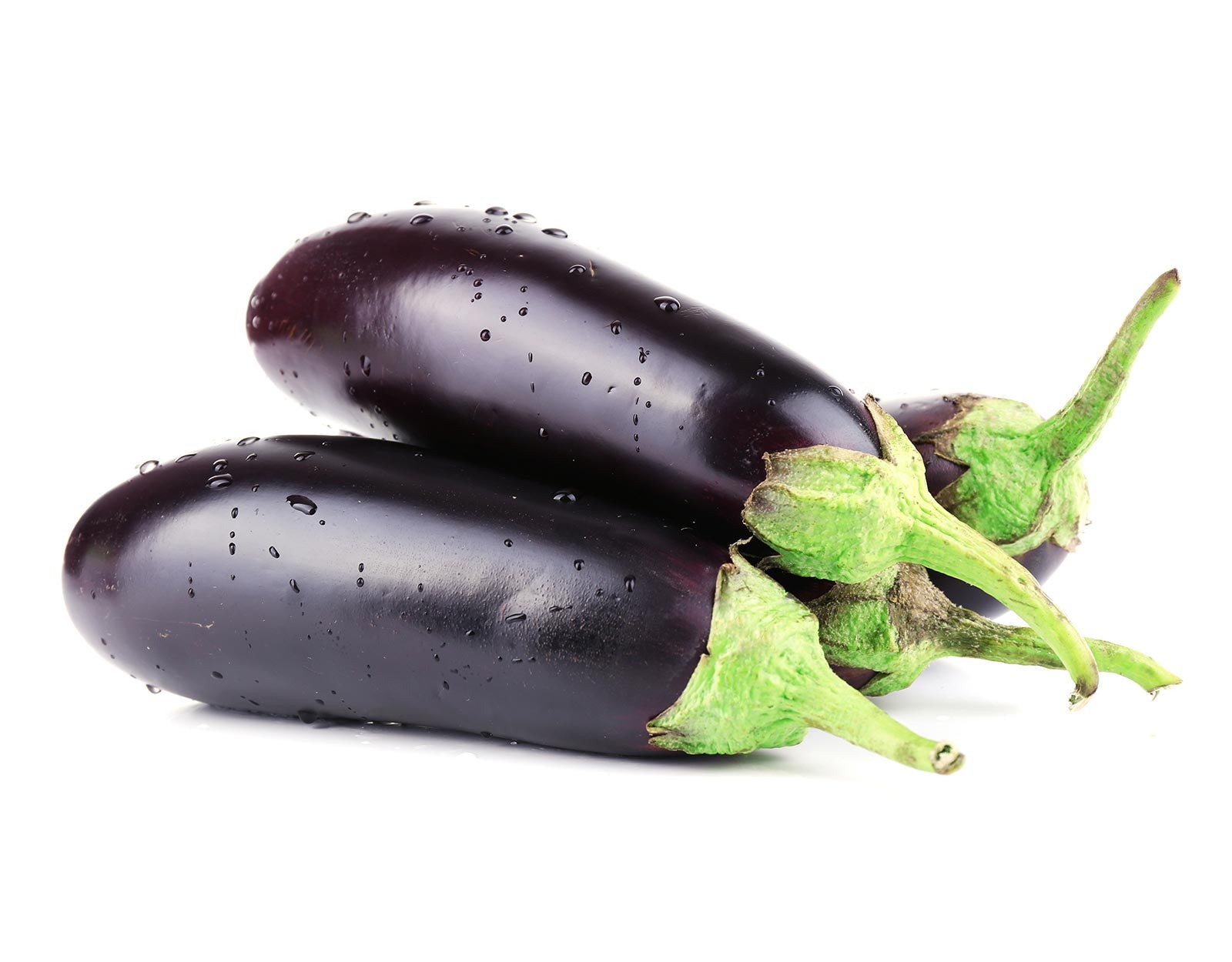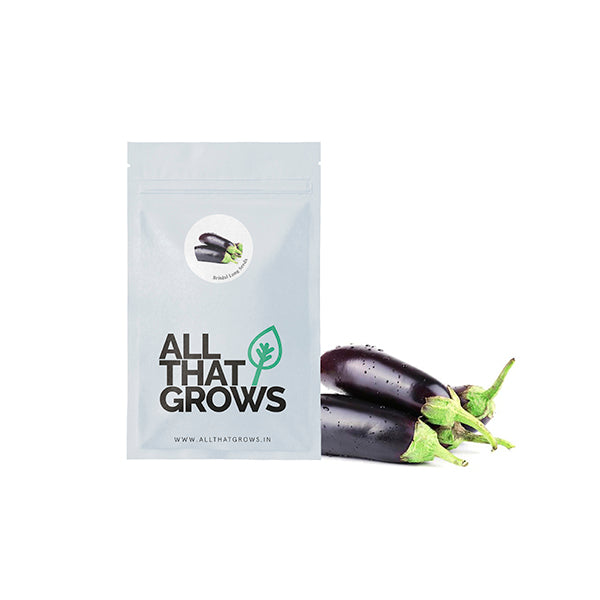



- SOWING
TIMEFeb - Mar
Jun - Jul - Sowing
DistancePlant to plant - 1'
Line to line - 1.5' - Fruit
WeightAverage fruit weight
of 55-60g - Fruit
Shapelong
- Days to
maturity90 - 100 days
- Details
- How to sow
- Reviews
This the long, purple, and fleshly variety and the most commonly available one too. The Brinjal or the Eggplant belongs to the Eggplant is a member of the Solanaceae or the family of the nightshades, which includes tomatoes, potatoes, and peppers. This vegetable is extremely healthy to eat as it is low in calories and high in soluble dietary fiber. It is also a very adaptable plant and hence can grow in tropical and sub-tropical regions. The brinjal is known to be a native of the South-Asian countries such as India, Sri Lanka, and China but now it is widely grown in Europe, Middle East, and Africa too. Aubergine, is the name given to the Brinjal in the Western part of the world. Botanically the brinjal is a berry with glossy, smooth skin, and an internal soft pulp. It can be cooked in a variety of ways from baking, roasting, grilling, to boiling, frying or braising. The skin of the fruit is very rich in anti-oxidants phenolic flavonoid phytochemicals called anthocyanins. Apart from that, the fruit also consists of many micronutrients such as B1, B5, B6 and fights cholesterol in the body. The Eggplant is also mineral rich with iron, copper, and manganese found in good quantity. When cooked in combination with other vegetables, the eggplant tastes really good. So add it to your staple diet and enjoy a happy healthy meal!
Planting instructions
Soak the seeds overnight to promote germination.
Start planting indoors 2 months before the soil warms up and keep in a warm place inside the house.
Sow seeds about 10 mm, 24 to 30 inches apart in well-prepared beds.
Transplant the seedlings when they have grown a couple of leaf sets.
Pinch out the terminal growing tips for a bushier plant.
Growing Requirements
watering
Evenly moist soil ensures faster growth. Do not overwater or allow the soil to dry out.
pests
The crop is vulnerable to the following pests - Aphids, Spider Mites, Tomato Hornworms, Downy and Powdery Mildew. Eggplant fruit may not ripen properly due to cold temperatures, pest damage, or infertile soils. Symptoms of crop infection include wilting of leaves, followed by the edges of the leaves becoming dry, brittle and eventually turning brown. The area between the veins in eggplant leaves may also become yellow. The plant's entire vascular system including the roots and stems gets affected leading to its collapse.
soil
Eggplant prefers a sandy soil with a pH of 5.5 to 6.8
spot
Grow eggplant in full sun
temperature
This crop requires a moderate warm temperature and it cannot withstand frost. Brinjal requires a minimum temperature of 18 C (65 F) during early growth, but optimal temperature is in the range of 24–27 C (75-80 F)
how to harvest
Harvest 16 to 24 weeks after sowing, when the skin of the fruit is shiny and unwrinkled.
Cut the fruit close to the stem and leave about an inch of it attached.
Eggplants can be stored for up to two weeks in humid conditions no lower than 10 degrees F.

Customer Reviews
The productiveness of any seed we sell is subject to your local climatic conditions*, the sowing method you adopt, and your commitment to the planting process. We give no warranty, expressed or implied, and are in no way responsible for the produce.
Please note that all our seasonal recommendations/ sowing information is as per the local climatic conditions. *For more information on the optimum conditions required for growing seeds in your region, please contact us at, hello@allthatgrows.in or Whatsapp us at, +91 8544865077
Questions & Answers
Have a Question?
Be the first to ask a question about this.




Brinjal Long Seeds
Seed Type : Non-Hybrid, Open Pollinated and Non-GMO
Plant : Erect, bushy without spines
Fruit : Fruits are long and purple in colour. Cluster bearing. Average fruit weight of 55-60g
Maturity : Harvesting starts in about 90 - 100 days from planting
This the long, purple, and fleshly variety and the most commonly available one too. The Brinjal or the Eggplant belongs to the Eggplant is a member of the Solanaceae or the family of the nightshades, which includes tomatoes, potatoes, and peppers. This vegetable is extremely healthy to eat as it is low in calories and high in soluble dietary fiber. It is also a very adaptable plant and hence can grow in tropical and sub-tropical regions. The brinjal is known to be a native of the South-Asian countries such as India, Sri Lanka, and China but now it is widely grown in Europe, Middle East, and Africa too. Aubergine, is the name given to the Brinjal in the Western part of the world. Botanically the brinjal is a berry with glossy, smooth skin, and an internal soft pulp. It can be cooked in a variety of ways from baking, roasting, grilling, to boiling, frying or braising. The skin of the fruit is very rich in anti-oxidants phenolic flavonoid phytochemicals called anthocyanins. Apart from that, the fruit also consists of many micronutrients such as B1, B5, B6 and fights cholesterol in the body. The Eggplant is also mineral rich with iron, copper, and manganese found in good quantity. When cooked in combination with other vegetables, the eggplant tastes really good. So add it to your staple diet and enjoy a happy healthy meal!
Seed Type : Non-Hybrid, Open Pollinated and Non-GMO
Plant : Erect, bushy without spines
Fruit : Fruits are long and purple in colour. Cluster bearing. Average fruit weight of 55-60g
Maturity : Harvesting starts in about 90 - 100 days from planting
- SOWING
TIMEFeb - Mar
Jun - Jul - Sowing
DistancePlant to plant - 1'
Line to line - 1.5' - Fruit
WeightAverage fruit weight
of 55-60g - Fruit
Shapelong
- Days to
maturity90 - 100 days
Planting instructions
Soak the seeds overnight to promote germination.
Start planting indoors 2 months before the soil warms up and keep in a warm place inside the house.
Sow seeds about 10 mm, 24 to 30 inches apart in well-prepared beds.
Transplant the seedlings when they have grown a couple of leaf sets.
Pinch out the terminal growing tips for a bushier plant.
Growing Requirements
watering
Evenly moist soil ensures faster growth. Do not overwater or allow the soil to dry out.
pests
The crop is vulnerable to the following pests - Aphids, Spider Mites, Tomato Hornworms, Downy and Powdery Mildew. Eggplant fruit may not ripen properly due to cold temperatures, pest damage, or infertile soils. Symptoms of crop infection include wilting of leaves, followed by the edges of the leaves becoming dry, brittle and eventually turning brown. The area between the veins in eggplant leaves may also become yellow. The plant's entire vascular system including the roots and stems gets affected leading to its collapse.
soil
Eggplant prefers a sandy soil with a pH of 5.5 to 6.8
spot
Grow eggplant in full sun
temperature
This crop requires a moderate warm temperature and it cannot withstand frost. Brinjal requires a minimum temperature of 18 C (65 F) during early growth, but optimal temperature is in the range of 24–27 C (75-80 F)
how to harvest
Harvest 16 to 24 weeks after sowing, when the skin of the fruit is shiny and unwrinkled.
Cut the fruit close to the stem and leave about an inch of it attached.
Eggplants can be stored for up to two weeks in humid conditions no lower than 10 degrees F.



 Sign In
Sign In








